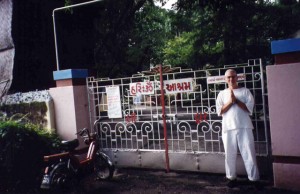About the Hari Om Ashram

About the Hari Om Ashram
by Hemantkumar Nilkanth
The author is a realized soul and a veritable light-house of spirituality. His disciples, friends and admirers affectionately call him ‘Mota’. In order to actualize his aspiration: “to light with Love some other souls”, he conducts ashramas in Nadiad, Surat and Kumbakonam. Unique opportunities are afforded to a seeker to start or quicken his pilgrimage of the soul.
On receiving prior intimation that it is his turn now, the seeker comes to the Ashrama and confines himself within a dark room never stepping out of it until a minimum period of twenty-one days is over (ed. Note: 7 days is now the minimum). A special bathroom and a closet for his exclusive use meet the needs of his body while food and other prime necessities are served to him in such a way as to prevent his seeing and coming into contact with any human being. The aspirant is thus entirely alone with himself and his Maker, and is expected to spend each day doing the ‘Japa’ (chanting the Lord’s name) of his choice, except during sleep. Some aspirants continue the ‘Japa’ even during the few hours allowed for meals, the reading of spiritual literature and the singing of hymns, or the recording of spiritual experiences. It is but fair that the aspirant should bear his own cost of food and other amenities provided for him during the period of solitude. Irrespective of sex, religion, and sect, any sincere seeker may participate in this activity of the ashrama.

This form of ‘Sadhana’ (process leading to self-realization), enables a man to appraise himself at his true value. For the first time he understands the numerous currents and undercurrents of his subconscious and unconscious mind, temperament and nature. All his anti-divine urges surge up and create a terrific struggle within him. But the remarkable fact is that the aspirant is sustained throughout his self chosen ordeal by the subtle protection and influence of the author (Mota) without which it would not only be difficult but almost impossible for the aspirant to remain confined to the room for such a long period. In order to give birth to a new life of the spirit and also to accelerate the pace of a pilgrim of the Way, this technique of Sadhana is unique both in its method and achievement.
Let it not be assumed, however, that it redeems the soul at a bound. All that one can say of it is that it does keep our spiritual powder dry and does train us in marksmanship so that we may ultimately shoot at the very Heart of the Target.

The Ashrama is not meant solely for those who wish to perform the ‘Japa’. Even those who do not perform the ‘Japa’ can come to stay there. But they must bear in mind that the sole object of the Ashrama is the evolution of a human being into the Divine. And with this object in view they should fulfill the necessary conditions of purity, chastity, sincerity, one-pointed devotion, serenity in thought, word and deed, and mutual cooperation and love. Everyone in the Ashrama must consider the other as a distinct unit, and individual ‘Jiva’ (soul) in search of the Divine. The Ashrama is not a sort of pleasure resort, nor a nest for indolent, selfish, self-contentious, self-righteous and somnolent souls who are completely material-minded and in whose hearts the flame of Divine Love is completely dormant.
There are no servants in the Ashrama, and those who would like to share in the Ashrama work are encouraged to do so with the conscious purpose of their self development. Not earlier than eight in the night nor later than four in the morning is the time for sleep and waking up. Morning and evening meals are served at 10:30 am and 6 pm. All possible regularity is expected from inmates in such matters.
For him who yearns to think of, meditate on, and be one with the Divine, for him who is anxious to dive into the unknown depths of his being and find the Self within, for him who aspires to divinise his entire being — for such a one is this Ashrama meant.
